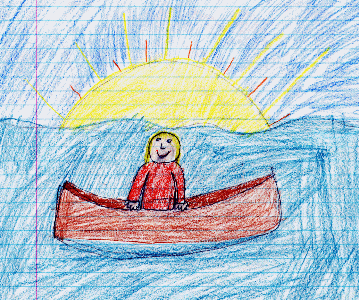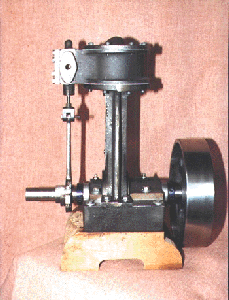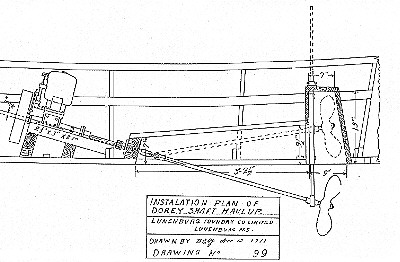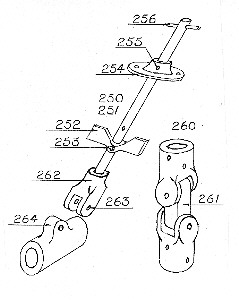
WebLetter 7
An Occasional Publication for the Home Boat Builder
Glen-L Marine Designs - 9152 Rosecrans Ave. - Bellflower, CA 90706
In this issue
- NEW Inboard Hardware Catalog
At last - Mr. Pearsall's boatbuilders
3rd grade students from Wilkes Elem. School, Bainbridge Island, WA - Steam Engine
Make your own? - Lift-up Prop
Drawing of lift-up prop shaft of type used in Lucky Pierre - Plywood boatbuilding for Virgin Builders
First of a series by Dick Koepp - Featured boat: JIMBO
Available in Stitch-N-Glue plywood and Aluminum - Book review: Boatbuilding with Plywood by Glen L.
Witt
A boatbuilding classic - Recent emails
Glen-L Update
- Web site:
On 29 October, our web site was "transferred" from an old computer to a new computer by our IP (Internet Provider). Well, like most things computer, it didn't work as planed. The site was down for a day, and various components, Order Form, Boatbuilder Connection, etc., were not fully operational until 6 November. This slowed down progress on other site related projects, but hopefully everything is now on track.
Since the last Web Letter we have added another catalog to the site: Inboard Marine Hardware. This catalog features almost everything you will need to install or retrofit an inboard engine in a boat. It was a lot of work to get it together, but we are happy with the results. As of now, we do not have an Inboard Hardware Order Form, hope to have one soon.- Boatbuilder Connection still needs to be updated.... soon we hope.
- Our "Boat Speak" glossary of boatbuilding terms has been taken out of the 4 Web Letters where they appeared and is now in MISC pages.
- Have you checked the MISC pages recently? We frequently put information in there in response to customer queries.
- We have also been changing the look of some of the pages and hope to re-do the home page soon.
- We don't have a FEED BACK section in this Web Letter. See Customer Photos, many of the photos have letters attached. We can get the information out more quickly by posting it here than waiting for the next Web Letter.
- With the holidays coming up you might want to consider our GIFT CERTIFICATE. If you happen to be hard to buy for, you might want to offer the idea of a Glen-L Gift Certificate to family and friends.
- We are very pleased to have the first of a series of articles from one of our builders, Dick Koepp. We hope to have other articles from builders in the next Web Letter.
- JIMBO! Stitch-N-Glue or aluminum garvey hull now ready. See below.
Barry Witt
Editor
Our new on-line Inboard Hardware catalog
As I'm writing this, I'm hoping the catalog will be ready by WebLetter e-time. We've had server problems and problems with the order form. When you visit, the catalog should be up, but the order form is still iffy.
The catalog features a line of rudders, struts, logs, stuffing boxes, and lightweight aluminum auto/marine conversion parts. Also included are CASALE V-Drives and VELVET-DRIVE Marine Transmissions. If you're outfitting a power boat, come and browse, there's not charge for looking. Also see the page "A brief description of parts" for description of parts used in a typical installation. (Inboard Hardware Catalog)
V-Drive boats
If you are interested in vee drive boats, check out: www.v-driveboats.com
The club has over 400 members and sponsers several events throughout the boating season.Also www.angelfire.com/az/vdriveboat. This is a private page looking for support from others interested in vee drive boats.
Mr. Pearsall's boatbuilders

Drawing by Becky G.
It's never too early to start building boats. Mr. Pearsall of Wilkes Elementary School on Bainbridge Island, WA is using a boatbuilding project as a way to teach his third grade class measuring, problem solving, and letter writing. For more information, see... Project Registry. We hope to be adding student reports on the progress of the project.
A Steam Engine You Can Make?

Peter Carlich of Reliable Steam Engines offers kits to build your own steam engine. The kits consist of castings that require machining, so may not be for everyone. If you're not up to building your own, Peter also offers completed engines as well as boilers and other accessories. The photo at the right is his simplest vertical steam engine with a rating of 4 hp at 125 psi and 600 rpm. Peter's most popular marine steam engine, is the 2 cylinder Reliable 5 HP Compound Engine.
Visit his site for more information on these engines and other products. The site is slow to load, but worth the wait if you're into stream power. URL: www.pioneer.net/~carlich
Lift-up Prop
Several customers have asked about a lift-up propeller for use on the Lucky Pierre (DESIGNS/Workboats). The drawings below are from an old catalog from Lunenburg Foundry in Nova Scotia, Canada. It my understanding that they no longer catalog the parts, but "still have the patterns".
 
Contact: Lunenburg Foundry |
The holidays are coming
up,
make it easy for your family and friends (and avoid another of those
neckties),
suggest a Glen-L Gift
Certificate
Plywood Boatbuilding for Virgin Builders
by: Dick Koepp
Part I - GETTING STARTED
I began building my first boat in 1965. Using some plans from a library book, I managed to build a small 8' dingy. I had no power tools, and only a handful of basic tools. I turned each screw by hand and sawed each board by hand. That experience taught me that hand tools needed to be upgraded to power, or the frustration level and success level would degrade proportionately.
The first Glen L boat I built was the "Playpen". I built my first one in 1972; (I ended up modifying the boat many times after that with new versions). I built it with strict adherence to the plans. As many have pointed out previously, it always helps to read the plans carefully. I took great pains to understand exactly what was required by each statement in the building instructions and tried to plot each back to the drawings that accompany them. What was obvious to the rest of the world, was gibberish to me, I called Glen-L and talked to an architect, and got the best advise I could have gotten: "Buy a copy of our book, 'Boatbuilding With Plywood'". That saved me. I have not since found a better basic woodworking book for small boat construction. All of the terms used in the plans are defined and exampled in this book, as well as a chapter on how to fiberglass hulls. (NOTE: I have only built Glen-L designs over the past 30 years, but other companies should follow these same guidelines.)
Featured boat: Jimbo
We've been telling you about the Jimbo, "soon to be available", for months... well it's here. The project expanded from stitch-n-glue plywood only, to both a s-n-g and an aluminum option. We've had a lot of requests for a small aluminum boat and designed Jimbo to meet the needs asked for by our customers.
The Jimbo is a 16' garvey hull with a shallow 6" draft at 890 lbs. total displacement. The bare hull/deck weighing in at approximately 450 lbs. Whether you want to build in plywood or aluminum, we hope you'll take a look at Jimbo. For further information and drawings, see Jimbo in the Outboard section of the Boat Design Catalog.
Book review: BOATBUILDING WITH PLYWOOD
Boatbuilding with Plywood was written by our founder, Glen L. Witt. Although there are other books on boatbuilding, most are dedicated to "traditional" methods with a page or two about plywood construction. While there are certainly people who want to build boats by traditional methods and learn about boatbuilding history, the majority of boats built at home are made with plywood.
Boatbuilding with Plywood is currently being used as the text book in college level boatbuilding classes in the US and Canada, but we are particularly proud that the book is often recommended by builders like Mr. Koepp. (See our Books page)
As I was getting this WebLetter ready, Darla found the following in the Nov/Dec Letters section of "Boatbuilder" magazine.
| Extra-long Plywood? I am trying to locate oversize plywood panels to build a 26-foot center
console using sewn-seam method. I've called Harbor Sales in New York, but
they no longer produce the panels. (Six panels are required. My first choice is
Douglas fir marine plywood, 1/2-inch x 4 feet x 28 feet. I could use
26-foot-long sheets, but no shorter.) Back in the days before epoxy resin came into widespread use, many lumber suppliers offered plywood in long panels that were scarfed up from 8-foot sheets and glued with resorcinol (which requires high pressure). With epoxy, which doesn't require pressure for a good bond, anyone who can build a boat can easily scarf the necessary panels to the required length. If the lumber merchants are no longer offering these longer sheets, we suspect it's because the shipping charges were high and the demand low. If you're not familiar with the technique of scarfing, you'll find all you need to know in Glen Witt's Boatbuilding with Plywood or The Gougeon Brothers on Boat Construction. See: Useful Information and Suppliers/Links: Other sites.../Boating magazines page for Boatbuilder's address. |
POXY-SHIELD: The boatbuilder epoxy
For making scarf joints, we use POXY-SHIELD epoxy resin, thickened with our #1 Silica. The silica allows more epoxy to be put into the joint and bridge any imperfections on the surfaces. POXY-SHIELD is the resin we use for gluing, coating, filleting, and fiberglassing for all of our shop boatbuilding projects. See BOATBUILDING SUPPLIES/Epoxy for more information.
Recent email:
What should I expect to pay for 4mm okoume plywood?
ANS: From Europe, $70-$75; from Israel somewhat less. On our website, MISC/List of Lumber Suppliers, is a listing for Harbor Sales, Baltimore, MD with an 800 number. Give them a call for exact price.
I have been looking for a light weight duck hunting boat without having to take a second mortgage. Reviewing your web page I noticed some of your plans include aluminum except for your duck boat plans. Is there any reason why aluminum cannot be used? Since I am not a boat builder, if aluminum could be used to build a duckboat do you have a source that could do the construction?
ANS:An aluminum duck boat would be heavier than plywood, certainly more expensive, and aluminum tends to be noisy. Not a good attribute in a duck boat. Small aluminum production boats use thin aluminum with riveted seams which is impractical for the home builder. Welded hulls are heavier than plywood. Other than that, any boat that can be built in sheet plywood could be in aluminum. No specifications are available for aluminum construction.
I have been looking for quite some time for a design that I would like to
build. Although I have taken a boat building course at Plymouth Plantation, I
have never built a boat on my own. I work as a designer and have done drawings
both on the board and CAD so I feel confident that I could loft the design full
size. Problem is that I don't have a decent surface to loft on.
My question is, do the full size patterns eliminate the need for lofting or is
lofting required for other components?
ANS: No lofting required.
Sirs,
I am considering building the Tiny Titan but have a question about
seating.
Do you sit, kneel, or is there a hump you squat on with your legs tucked behind
you like a snowmobile? I can't tell from the pictures and want to know
before ordering plans.
ANS:You kneel. This also true of the Super Spartan, Picklefork, XP8, and Tunnel Mite.
Subject: Re: Poxy-Shield
I have a 26' Owens (plywood hull). Can i use Poxy-Shield to paint the seams on the outside before i paint the bottom with bottom paint.
ANS:Yes, as long as sanded to bare wood, but not sure of the purpose. If the boat is not fiberglassed and you want to protect the planking junction, would recommend fiberglass tape and epoxy. To help in blending into the hull surface, would use microspheres as an additive to the final coat of resin. Products described in BOATBUILDING SUPPLIES/Epoxy and Fiberglass Cloth on our website.
Subject: Re: Power Skiff 14 Sail Rig?
Glen-L-
I purchased plans for the Power Skiff 14' a couple of years ago. I am
now thinking of building it and would like to know if it could be fitted with a
basic sail rig and used as a small inland lake sail boat? Please offer your
opinion on this question as well as any considerations that should be taken if
this is possible. If using the Power Skiff as a sail boat is not feasible than
please offer a suggestion for a small, easy to build sailboat, suitable for use
on small lakes by inexperienced young people and adults alike.
Thank you.
ANS: Planing power boats do not generally make good sailboats, although we have had the Power Skiff built as sailboat. For 1 to 2 people would recommend the 8 Ball, Bulls Eye, or Glen-L 10 as easy to build. The Glen-L 10 would be more of a performance boat. Other designs would get progressively more complicated.
Build more boats
Glen-L boats, of course